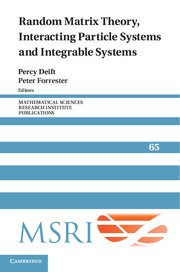Book contents
- Frontmatter
- Contents
- Preface
- Universality conjecture for all Airy, sine and Bessel kernels in the complex plane
- On a relationship between high rank cases and rank one cases of Hermitian random matrix models with external
- Riemann–Hilbert approach to the six-vertex model
- CLT for spectra of submatrices of Wigner random matrices, II: Stochastic evolution
- Critical asymptotic behavior for the Korteweg–de Vries equation and in random matrix theory
- On the asymptotics of a Toeplitz determinant with singularities
- Asymptotic analysis of the two-matrix model with a quartic potential
- Conservation laws of random matrix theory
- Asymptotics of spacing distributions 50 years later
- Applications of random matrix theory for sensor array imaging with measurement noise
- Convolution symmetries of integrable hierarchies, matrix models and τ-functions
- Universality limits via “old style” analysis
- Fluctuations and large deviations of some perturbed random matrices
- Three lectures on free probability
- Whittaker functions and relatedstochastic processes
- How long does it take to compute the eigenvalues of a random symmetric matrix?
- Exact solutions of the Kardar–Parisi–Zhang equation and weak universality for directed random polymers
- Replica analysis of the one-dimensional KPZ equation
- Asymptotic expansions for β matrix models and their applications to the universality conjecture
- KPZ scaling theory and the semidiscrete directed polymer model
- Experimental Realization Of Tracy–Widom Distributions And Beyond: Kpz Interfaces In Turbulent Liquid Crystal
- Random matrices: the four-moment theorem for Wigner ensembles
KPZ scaling theory and the semidiscrete directed polymer model
Published online by Cambridge University Press: 29 May 2025
- Frontmatter
- Contents
- Preface
- Universality conjecture for all Airy, sine and Bessel kernels in the complex plane
- On a relationship between high rank cases and rank one cases of Hermitian random matrix models with external
- Riemann–Hilbert approach to the six-vertex model
- CLT for spectra of submatrices of Wigner random matrices, II: Stochastic evolution
- Critical asymptotic behavior for the Korteweg–de Vries equation and in random matrix theory
- On the asymptotics of a Toeplitz determinant with singularities
- Asymptotic analysis of the two-matrix model with a quartic potential
- Conservation laws of random matrix theory
- Asymptotics of spacing distributions 50 years later
- Applications of random matrix theory for sensor array imaging with measurement noise
- Convolution symmetries of integrable hierarchies, matrix models and τ-functions
- Universality limits via “old style” analysis
- Fluctuations and large deviations of some perturbed random matrices
- Three lectures on free probability
- Whittaker functions and relatedstochastic processes
- How long does it take to compute the eigenvalues of a random symmetric matrix?
- Exact solutions of the Kardar–Parisi–Zhang equation and weak universality for directed random polymers
- Replica analysis of the one-dimensional KPZ equation
- Asymptotic expansions for β matrix models and their applications to the universality conjecture
- KPZ scaling theory and the semidiscrete directed polymer model
- Experimental Realization Of Tracy–Widom Distributions And Beyond: Kpz Interfaces In Turbulent Liquid Crystal
- Random matrices: the four-moment theorem for Wigner ensembles
Summary
We explain how the claims of KPZ scaling theory are confirmed by a recent proof of Borodin and Corwin on the asymptotics of the semidiscrete directed polymer.
1. Introduction
The Kardar–Parisi–Zhang (KPZ) equation [1986] is a stochastic partial differential equation modeling surface growth and, more generally, the motion of an interface bordering a stable against a metastable phase. Scaling theory is an educated guess on the nonuniversal coefficients in the asymptotics for models in the KPZ universality class. Scaling theory has been developed in a landmark contribution by Krug, Meakin and Halpin-Healy [Krug et al. 1992]. The purpose of our article is to explain how to apply scaling theory to the semidiscrete directed polymer. This model has been discussed in depth at the 2010 random matrix workshop at MSRI and, so-to-speak as a spin-off, Borodin and Corwin [2014] developed the beautiful theory of Macdonald processes, which provides the tools for an asymptotic analysis of the semidiscrete directed polymer. As we will establish, scaling theory is consistent with the results of Borodin and Corwin, thereby providing a highly nonobvious control check.
To place the issue in focus, let me start with a simple example. Assume as given the stationary sequence Xj , j ∈ ℤ, of mean zero random variables and let us consider the partial sums
As well studied, it is fairly common that Sn/√n converges to a Gaussian as n→∞, i.e.,
where FG is the distribution function of a unit Gaussian random variable. Here FG is the universal object, while the coefficient D > 0 depends on the law ℙ and
is in this sense model dependent, resp. nonuniversal. However, using stationarity, D is readily guessed as
The KPZ class deals with strongly dependent random variables, for which partial sums are of size n⅓ rather than n½. FG is to be substituted by the GUE Tracy–Widom distribution function, FGUE, which first appeared in the context of the largest eigenvalue of a FGUE random matrix [Forrester 1993; Tracy and Widom 1994].
Information
- Type
- Chapter
- Information
- Publisher: Cambridge University PressPrint publication year: 2014
Accessibility standard: Unknown
Why this information is here
This section outlines the accessibility features of this content - including support for screen readers, full keyboard navigation and high-contrast display options. This may not be relevant for you.Accessibility Information
- 4
- Cited by
